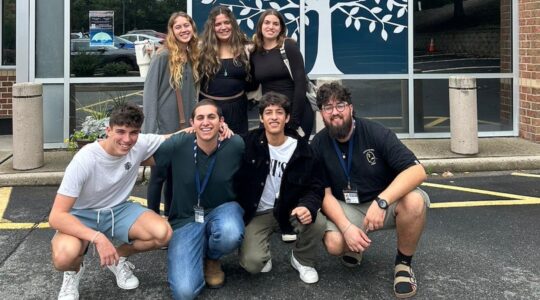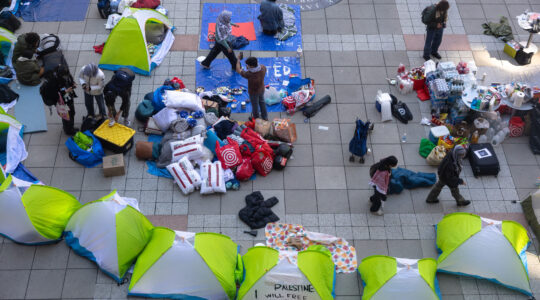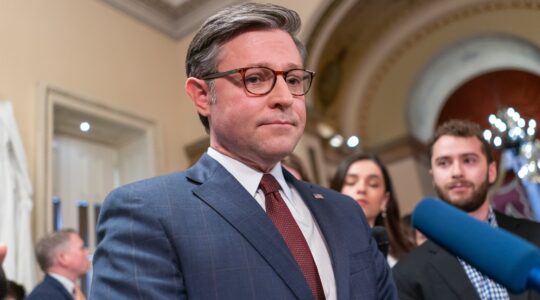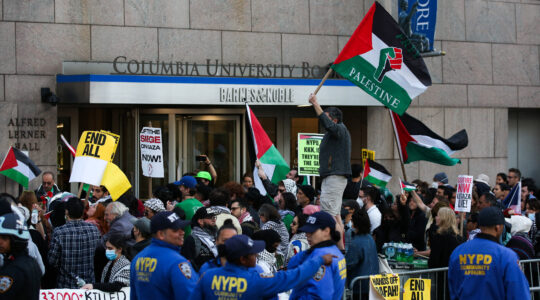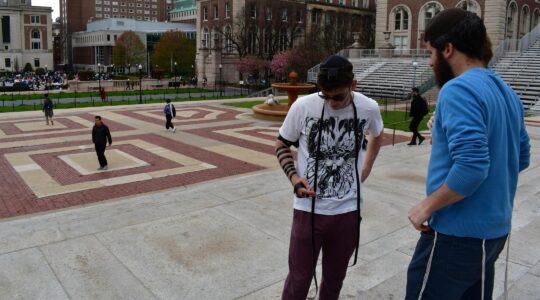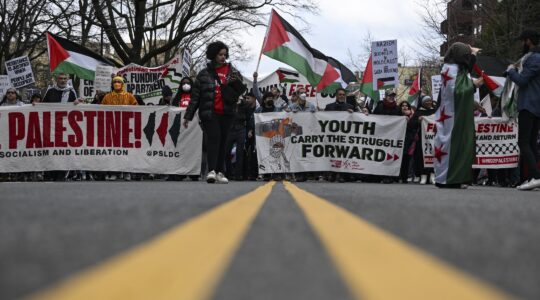NEW YORK (JTA) – If the producers of “Constantine’s Sword” were looking to send a message about the implications of their film for Catholic-Jewish relations, they scarcely could have chosen a more appropriate theatrical release date.
On Friday, April 18, within hours of the film’s first New York screening, Pope Benedict XVI made a historic visit to an American synagogue – a gesture of goodwill observers say is intended to smooth over feelings unsettled by the pope’s recent revival of a prayer for Jewish conversion.
The documentary, which traces the violent history of Church-sanctioned anti-Semitism, is a powerful reminder of why many Jewish leaders regard the prayer not as the Vatican has tried to spin it – as an inconsequential matter of internal Church politics – but as a dangerous step back from decades of Jewish-Catholic rapprochement.
For the filmmakers, the timing of the release presents a more prosaic concern. Movies often sink or swim based on the opening weekend box office, and given the coincidence with Passover – the holiday began Saturday at sunset – Jewish turnout might be lower than expected.
“It’s not a weekend we would have chosen,” Oren Jacoby, the film’s director, told JTA.
For those with trouble appreciating why an ancient prayer said once a year by a minority of the world’s Catholics is cause for such alarm, “Constantine’s Sword” should serve as a useful primer.
Based on the book by James Carroll, a Boston Globe columnist and former Roman Catholic priest, the film visits five countries to discover the sources of Catholic anti-Semitism, the violent manifestations of that hatred through the centuries and the ways it continues to reverberate today.
In Carroll’s telling, Catholic hostility to Jews goes back at least to the fourth century, when the emperor Constantine conquered Rome, carrying a sword fashioned as a cross. At the time, he says in the film, there were roughly the same number of Jews as Christians in the world.
In subsequent centuries, the Church’s attitudes toward Jews ranged from cold tolerance to frenzied orgies of religiously inspired mass murder. Among the highlights of this tortured history is the total destruction of centers of Jewish life situated along the Rhine river in 1096. As the Crusaders journeyed to the Holy Land to make war on the Muslims – armed with shields bearing signs of the cross and with priests in the lead – they warmed up for the battles to come by wiping out the Jewish settlements in their path.
“The supremacy of the cross in European culture was responsible for the deaths of many of my people centuries before I was born,” the literary critic Leon Wieseltier says in the film, “and eventually for the death of my own family in southeastern Poland.”
But the film is more than a history lesson. In Carroll’s view, the Roman Catholic Church provides the model for religious intolerance and coercive missionizing still in force today.
In a sideplot grafted onto the larger story, Carroll visits the United States Air Force academy where allegations have surfaced of widespread Christian evangelizing and where a Jewish academy alumnus, Mikey Weinstein, has been fighting to preserve religious freedom in the military.
“That’s related to the ancient Christian impulse to convert Jews,” Carroll says of the air force controversy. “Why are Christians so dead set on the conversion of Jews? I think it’s because Jewish rejection of Christian claims goes to the heart of the ability of Christians themselves to believe what they proclaim.”
“A Hindu can reject Christian claims with no authority,” Carroll continued. “Jews are the custodians of the Hebrew scriptures on which Christian understanding of Jesus is based. So a Jewish rejection of the understanding that Christians have about Jesus is mortally threatening.”
That threat led to violent outbursts by the Church, which while fundamentally evangelical through much of its history, reserved particular animus for Jews. Carroll interviews the descendants of Italian Jews who for centuries were locked up in a fetid ghetto just yards away from the grand open spaces of Vatican City. When the Nazis arrived, the Vatican became the first foreign power to enter into a bilateral treaty with Hitler.
Cognizance of that history has prompted serious displeasure among Jewish leaders at the revival of a prayer for Jewish conversion. Carroll believes the Jewish community is rightly unnerved by this development.
He sees the prayer as a radical departure from Nostra Aetate, the 1965 Vatican declaration that the Jewish covenant with God is still operative, and as a return to the “triumphalist exclusivism” of the pre-Vatican II Church that insists Catholicism is the only path to God.
“In the 21st century,” Carroll says, “that is a formula for intolerance and ultimately for violence.”
Carroll doesn’t doubt that Benedict is a man of good will with honorable intentions, and he rejects the warning that the prayer, recited in the liturgy on Good Friday, will deal a sharp setback to Jewish-Catholic relations.
But he also sees the pope as limited by the theological orthodoxy to which he adheres, particularly his view of the Catholic Church as the only true path to salvation. As a result, the pope is loath to admit the Church’s crimes.
Case in point is Benedict’s failure, during another historic synagogue appearance, in Cologne in 2005, to acknowledge the Christian roots of Nazi anti-Semitism. In that speech, Benedict identified “neo-paganism” as the forebear of Nazi ideology, but Carroll says that’s only part of the story. That hatred had two parents, Carroll earnestly tells the camera, his ruddy face visibly tortured by the confession.
It’s hard to imagine Benedict will do much better this time around. Jewish leaders, keenly attuned to the nuances of church language, will be parsing Benedict’s every utterance during his synagogue visit and in a separate meeting with Jewish leaders the day before, in Washington.
But Carroll evinces little worry that the pope reflects a fundamental return to the past. The Church’s older guard is dying off, he says, and everything from the shortage of Catholic priests to the loss of credibility after the priest sex scandals suggests to him that change is afoot.
“These are signals of an institution in serious transition,” Carroll says. “And I think that Pope Benedict is the last of the old order, not the beginning of something new.”
All of this is heady stuff. But in the hands of Jacoby, a gifted filmmaker who was nominated for an Academy Award for “Sister Rose’s Passion,” another film dealing with Catholic anti-Semitism, the film moves along with a buoyancy more typical of a thriller than a documentary about arcane matters of religious theology.
It is sustained by the moving story of Carroll himself – a man whose disillusion with what he sees as the false piety of the Vatican, and its silence during the Vietnam war, drove him from the priesthood.
But unlike many who lose faith, Carroll is not angry. He remains devout and his tone throughout the film is less the rebellious son than the forgiving father.
“The sins of the church are exactly the sins of human beings, of whom I am one,” Carroll says. “And the church is a home for me because the good news isn’t that God has come to a holy people. The good news is that God has come to sinners.”
